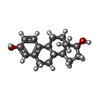[English] 日本語
 Yorodumi
Yorodumi- PDB-1qku: WILD TYPE ESTROGEN NUCLEAR RECEPTOR LIGAND BINDING DOMAIN COMPLEX... -
+ Open data
Open data
- Basic information
Basic information
| Entry | Database: PDB / ID: 1qku | ||||||
|---|---|---|---|---|---|---|---|
| Title | WILD TYPE ESTROGEN NUCLEAR RECEPTOR LIGAND BINDING DOMAIN COMPLEXED WITH ESTRADIOL | ||||||
 Components Components | ESTRADIOL RECEPTOR Estrogen receptor Estrogen receptor | ||||||
 Keywords Keywords |  NUCLEAR RECEPTOR / NUCLEAR RECEPTOR /  AGONISM / ANTAGONISM / AGONISM / ANTAGONISM /  ESTRADIOL RECEPTOR / ESTRADIOL RECEPTOR /  STEROID / STEROID /  STRUCTURAL PROTEOMICS IN EUROPE / SPINE / STRUCTURAL PROTEOMICS IN EUROPE / SPINE /  STRUCTURAL GENOMICS STRUCTURAL GENOMICS | ||||||
| Function / homology |  Function and homology information Function and homology informationregulation of epithelial cell apoptotic process / antral ovarian follicle growth / G protein-coupled estrogen receptor activity / regulation of branching involved in prostate gland morphogenesis / RUNX1 regulates transcription of genes involved in WNT signaling / RUNX1 regulates estrogen receptor mediated transcription /  regulation of toll-like receptor signaling pathway / prostate epithelial cord arborization involved in prostate glandular acinus morphogenesis / nuclear estrogen receptor activity / epithelial cell proliferation involved in mammary gland duct elongation ...regulation of epithelial cell apoptotic process / antral ovarian follicle growth / G protein-coupled estrogen receptor activity / regulation of branching involved in prostate gland morphogenesis / RUNX1 regulates transcription of genes involved in WNT signaling / RUNX1 regulates estrogen receptor mediated transcription / regulation of toll-like receptor signaling pathway / prostate epithelial cord arborization involved in prostate glandular acinus morphogenesis / nuclear estrogen receptor activity / epithelial cell proliferation involved in mammary gland duct elongation ...regulation of epithelial cell apoptotic process / antral ovarian follicle growth / G protein-coupled estrogen receptor activity / regulation of branching involved in prostate gland morphogenesis / RUNX1 regulates transcription of genes involved in WNT signaling / RUNX1 regulates estrogen receptor mediated transcription /  regulation of toll-like receptor signaling pathway / prostate epithelial cord arborization involved in prostate glandular acinus morphogenesis / nuclear estrogen receptor activity / epithelial cell proliferation involved in mammary gland duct elongation / epithelial cell development / prostate epithelial cord elongation / negative regulation of smooth muscle cell apoptotic process / mammary gland branching involved in pregnancy / uterus development / vagina development / TFIIB-class transcription factor binding / androgen metabolic process / steroid hormone mediated signaling pathway / mammary gland alveolus development / intracellular estrogen receptor signaling pathway / cellular response to estrogen stimulus / regulation of toll-like receptor signaling pathway / prostate epithelial cord arborization involved in prostate glandular acinus morphogenesis / nuclear estrogen receptor activity / epithelial cell proliferation involved in mammary gland duct elongation / epithelial cell development / prostate epithelial cord elongation / negative regulation of smooth muscle cell apoptotic process / mammary gland branching involved in pregnancy / uterus development / vagina development / TFIIB-class transcription factor binding / androgen metabolic process / steroid hormone mediated signaling pathway / mammary gland alveolus development / intracellular estrogen receptor signaling pathway / cellular response to estrogen stimulus /  estrogen response element binding / estrogen response element binding /  : / intracellular steroid hormone receptor signaling pathway / negative regulation of canonical NF-kappaB signal transduction / Nuclear signaling by ERBB4 / RNA polymerase II preinitiation complex assembly / protein localization to chromatin / 14-3-3 protein binding / TBP-class protein binding / : / intracellular steroid hormone receptor signaling pathway / negative regulation of canonical NF-kappaB signal transduction / Nuclear signaling by ERBB4 / RNA polymerase II preinitiation complex assembly / protein localization to chromatin / 14-3-3 protein binding / TBP-class protein binding /  steroid binding / nitric-oxide synthase regulator activity / TFAP2 (AP-2) family regulates transcription of growth factors and their receptors / ESR-mediated signaling / transcription corepressor binding / negative regulation of miRNA transcription / cellular response to estradiol stimulus / steroid binding / nitric-oxide synthase regulator activity / TFAP2 (AP-2) family regulates transcription of growth factors and their receptors / ESR-mediated signaling / transcription corepressor binding / negative regulation of miRNA transcription / cellular response to estradiol stimulus /  transcription coregulator binding / transcription coregulator binding /  stem cell differentiation / nuclear estrogen receptor binding / positive regulation of nitric-oxide synthase activity / SUMOylation of intracellular receptors / stem cell differentiation / nuclear estrogen receptor binding / positive regulation of nitric-oxide synthase activity / SUMOylation of intracellular receptors /  euchromatin / negative regulation of DNA-binding transcription factor activity / euchromatin / negative regulation of DNA-binding transcription factor activity /  beta-catenin binding / beta-catenin binding /  transcription coactivator binding / positive regulation of DNA-binding transcription factor activity / Nuclear Receptor transcription pathway / response to estrogen / Regulation of RUNX2 expression and activity / Constitutive Signaling by Aberrant PI3K in Cancer / transcription coactivator binding / positive regulation of DNA-binding transcription factor activity / Nuclear Receptor transcription pathway / response to estrogen / Regulation of RUNX2 expression and activity / Constitutive Signaling by Aberrant PI3K in Cancer /  nuclear receptor activity / positive regulation of nitric oxide biosynthetic process / male gonad development / positive regulation of fibroblast proliferation / sequence-specific double-stranded DNA binding / Ovarian tumor domain proteases / PIP3 activates AKT signaling / response to estradiol / phospholipase C-activating G protein-coupled receptor signaling pathway / nuclear receptor activity / positive regulation of nitric oxide biosynthetic process / male gonad development / positive regulation of fibroblast proliferation / sequence-specific double-stranded DNA binding / Ovarian tumor domain proteases / PIP3 activates AKT signaling / response to estradiol / phospholipase C-activating G protein-coupled receptor signaling pathway /  ATPase binding / positive regulation of cytosolic calcium ion concentration / ATPase binding / positive regulation of cytosolic calcium ion concentration /  regulation of inflammatory response / fibroblast proliferation / PI5P, PP2A and IER3 Regulate PI3K/AKT Signaling / DNA-binding transcription activator activity, RNA polymerase II-specific / Estrogen-dependent gene expression / regulation of inflammatory response / fibroblast proliferation / PI5P, PP2A and IER3 Regulate PI3K/AKT Signaling / DNA-binding transcription activator activity, RNA polymerase II-specific / Estrogen-dependent gene expression /  transcription regulator complex / Extra-nuclear estrogen signaling / transcription regulator complex / Extra-nuclear estrogen signaling /  calmodulin binding / DNA-binding transcription factor activity, RNA polymerase II-specific / calmodulin binding / DNA-binding transcription factor activity, RNA polymerase II-specific /  chromatin remodeling / RNA polymerase II cis-regulatory region sequence-specific DNA binding / DNA-binding transcription factor activity / negative regulation of gene expression / chromatin remodeling / RNA polymerase II cis-regulatory region sequence-specific DNA binding / DNA-binding transcription factor activity / negative regulation of gene expression /  chromatin binding / chromatin binding /  chromatin / regulation of DNA-templated transcription / regulation of transcription by RNA polymerase II / chromatin / regulation of DNA-templated transcription / regulation of transcription by RNA polymerase II /  protein kinase binding / positive regulation of DNA-templated transcription / protein kinase binding / positive regulation of DNA-templated transcription /  Golgi apparatus / Golgi apparatus /  enzyme binding / negative regulation of transcription by RNA polymerase II / enzyme binding / negative regulation of transcription by RNA polymerase II /  signal transduction / positive regulation of transcription by RNA polymerase II / protein-containing complex / zinc ion binding / signal transduction / positive regulation of transcription by RNA polymerase II / protein-containing complex / zinc ion binding /  nucleoplasm / nucleoplasm /  membrane / identical protein binding / membrane / identical protein binding /  nucleus / nucleus /  plasma membrane / plasma membrane /  cytosol / cytosol /  cytoplasm cytoplasmSimilarity search - Function | ||||||
| Biological species |   HOMO SAPIENS (human) HOMO SAPIENS (human) | ||||||
| Method |  X-RAY DIFFRACTION / X-RAY DIFFRACTION /  SYNCHROTRON / SYNCHROTRON /  MOLECULAR REPLACEMENT / Resolution: 3.2 Å MOLECULAR REPLACEMENT / Resolution: 3.2 Å | ||||||
 Authors Authors | Ruff, M. / Gangloff, M. / Eiler, S. / Duclaud, S. / Wurtz, J.M. / Moras, D. | ||||||
 Citation Citation |  Journal: J. Biol. Chem. / Year: 2001 Journal: J. Biol. Chem. / Year: 2001Title: Crystal structure of a mutant hERalpha ligand-binding domain reveals key structural features for the mechanism of partial agonism. Authors: Gangloff, M. / Ruff, M. / Eiler, S. / Duclaud, S. / Wurtz, J.M. / Moras, D. | ||||||
| History |
|
- Structure visualization
Structure visualization
| Structure viewer | Molecule:  Molmil Molmil Jmol/JSmol Jmol/JSmol |
|---|
- Downloads & links
Downloads & links
- Download
Download
| PDBx/mmCIF format |  1qku.cif.gz 1qku.cif.gz | 169.2 KB | Display |  PDBx/mmCIF format PDBx/mmCIF format |
|---|---|---|---|---|
| PDB format |  pdb1qku.ent.gz pdb1qku.ent.gz | 137.3 KB | Display |  PDB format PDB format |
| PDBx/mmJSON format |  1qku.json.gz 1qku.json.gz | Tree view |  PDBx/mmJSON format PDBx/mmJSON format | |
| Others |  Other downloads Other downloads |
-Validation report
| Arichive directory |  https://data.pdbj.org/pub/pdb/validation_reports/qk/1qku https://data.pdbj.org/pub/pdb/validation_reports/qk/1qku ftp://data.pdbj.org/pub/pdb/validation_reports/qk/1qku ftp://data.pdbj.org/pub/pdb/validation_reports/qk/1qku | HTTPS FTP |
|---|
-Related structure data
- Links
Links
- Assembly
Assembly
| Deposited unit | 
| ||||||||
|---|---|---|---|---|---|---|---|---|---|
| 1 | 
| ||||||||
| 2 | 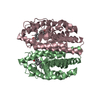
| ||||||||
| Unit cell |
| ||||||||
| Details | THE ASYMMETRIC UNIT CONTAINS 2 INDEPENDENT MOLECULES.CHAINS B AND C MAKE ONE HOMO-DIMER WITH CHAIN ACONSISTING OF ONE HALF OF A SECOND DIMER |
- Components
Components
| #1: Protein |  Estrogen receptor Estrogen receptorMass: 28619.727 Da / Num. of mol.: 3 / Fragment: LIGAND BINDING DOMAIN Source method: isolated from a genetically manipulated source Source: (gene. exp.)   HOMO SAPIENS (human) / Cellular location: NUCLEUS HOMO SAPIENS (human) / Cellular location: NUCLEUS Cell nucleus / Plasmid: PET15 / Cellular location (production host): CYTOPLASM / Production host: Cell nucleus / Plasmid: PET15 / Cellular location (production host): CYTOPLASM / Production host:   Escherichia coli BL21 (bacteria) / References: UniProt: P03372 Escherichia coli BL21 (bacteria) / References: UniProt: P03372#2: Chemical |  Estradiol Estradiol#3: Water | ChemComp-HOH / |  Water Water |
|---|
-Experimental details
-Experiment
| Experiment | Method:  X-RAY DIFFRACTION / Number of used crystals: 1 X-RAY DIFFRACTION / Number of used crystals: 1 |
|---|
- Sample preparation
Sample preparation
| Crystal | Density Matthews: 2.55 Å3/Da / Density % sol: 45 % |
|---|---|
Crystal grow | pH: 7 / Details: pH 7.00 |
| Crystal grow | *PLUS Method: otherDetails: This particular structure is not described in this paper. |
-Data collection
| Diffraction | Mean temperature: 110 K |
|---|---|
| Diffraction source | Source:  SYNCHROTRON / Site: SYNCHROTRON / Site:  ESRF ESRF  / Type: / Type:  ESRF ESRF  / Wavelength: 0.9 / Wavelength: 0.9 |
| Detector | Type: MARRESEARCH / Detector: IMAGE PLATE |
| Radiation | Protocol: SINGLE WAVELENGTH / Monochromatic (M) / Laue (L): M / Scattering type: x-ray |
| Radiation wavelength | Wavelength : 0.9 Å / Relative weight: 1 : 0.9 Å / Relative weight: 1 |
| Reflection | Resolution: 2.9→15 Å / Num. obs: 19255 / % possible obs: 96 % / Redundancy: 1.8 % / Biso Wilson estimate: 60 Å2 / Rsym value: 0.08 |
- Processing
Processing
| Software |
| ||||||||||||||||||||||||||||||||||||||||||||||||||||||||||||||||||||||||||||||||
|---|---|---|---|---|---|---|---|---|---|---|---|---|---|---|---|---|---|---|---|---|---|---|---|---|---|---|---|---|---|---|---|---|---|---|---|---|---|---|---|---|---|---|---|---|---|---|---|---|---|---|---|---|---|---|---|---|---|---|---|---|---|---|---|---|---|---|---|---|---|---|---|---|---|---|---|---|---|---|---|---|---|
| Refinement | Method to determine structure : :  MOLECULAR REPLACEMENT / Resolution: 3.2→15 Å / Rfactor Rfree error: 0.007 / Data cutoff high absF: 2087323.51 / Isotropic thermal model: RESTRAINED / Cross valid method: THROUGHOUT / σ(F): 0 MOLECULAR REPLACEMENT / Resolution: 3.2→15 Å / Rfactor Rfree error: 0.007 / Data cutoff high absF: 2087323.51 / Isotropic thermal model: RESTRAINED / Cross valid method: THROUGHOUT / σ(F): 0
| ||||||||||||||||||||||||||||||||||||||||||||||||||||||||||||||||||||||||||||||||
| Solvent computation | Solvent model: FLAT MODEL / Bsol: 12.9798 Å2 / ksol: 0.228664 e/Å3 | ||||||||||||||||||||||||||||||||||||||||||||||||||||||||||||||||||||||||||||||||
| Displacement parameters | Biso mean: 56.7 Å2
| ||||||||||||||||||||||||||||||||||||||||||||||||||||||||||||||||||||||||||||||||
| Refine analyze |
| ||||||||||||||||||||||||||||||||||||||||||||||||||||||||||||||||||||||||||||||||
| Refinement step | Cycle: LAST / Resolution: 3.2→15 Å
| ||||||||||||||||||||||||||||||||||||||||||||||||||||||||||||||||||||||||||||||||
| Refine LS restraints |
| ||||||||||||||||||||||||||||||||||||||||||||||||||||||||||||||||||||||||||||||||
| LS refinement shell | Resolution: 3.2→3.4 Å / Rfactor Rfree error: 0.027 / Total num. of bins used: 6
| ||||||||||||||||||||||||||||||||||||||||||||||||||||||||||||||||||||||||||||||||
| Xplor file |
| ||||||||||||||||||||||||||||||||||||||||||||||||||||||||||||||||||||||||||||||||
| Software | *PLUS Name: CNS / Version: 0.4 / Classification: refinement | ||||||||||||||||||||||||||||||||||||||||||||||||||||||||||||||||||||||||||||||||
| Refine LS restraints | *PLUS
|
 Movie
Movie Controller
Controller


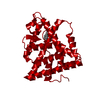
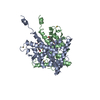

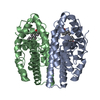




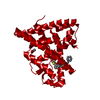
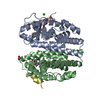


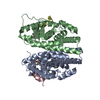



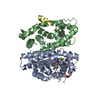




 PDBj
PDBj





